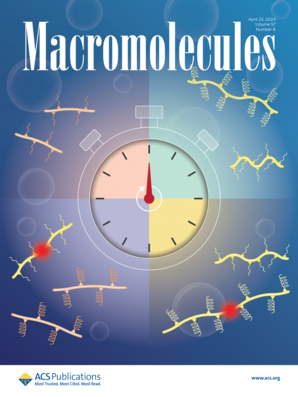超软带电球形胶束的玻璃化转变和屈服
IF 5.1
1区 化学
Q1 POLYMER SCIENCE
引用次数: 0
摘要
胶体被广泛用作研究玻璃化转变的模型体系,许多研究集中在硬或软中性胶体及其混合物上。然而,软带电球形胶体的玻璃化转变及其动力学效应仍未得到充分的研究。本研究利用剪切流变学、粗粒分子动力学(MD)模拟和x射线散射来评估聚合物多臂带电软胶体的玻璃化转变。由静电臂间斥力驱动的强粒子-粒子相关性抑制了稀态下的牛顿行为。液体到玻璃的转变发生在0.25 wt %,标志着弱笼化和最小的臂交叉,正如MD模拟中的颗粒接触分析和动态模量的强频率依赖性所证明的那样。粒子壳只有在玻璃态下才能很好地交叉,导致几乎不依赖于频率的流变响应。屈服应力的弱体积分数依赖性使这些带电体系成为文献中报道的最软的胶体。本文章由计算机程序翻译,如有差异,请以英文原文为准。

Glass Transition and Yielding of Ultrasoft Charged Spherical Micelles
Colloids are widely used as model systems to study the glass transition, with much research focused on hard or soft neutral colloids and their mixtures. However, the glass transition of soft-charged spherical colloids and its dynamic effects remain underexplored. This study assesses the glass transition of polymeric multiarm charged soft colloids using shear rheology, coarse-grained molecular dynamics (MD) simulations, and X-ray scattering. Strong particle–particle correlations, driven by electrostatic interarm repulsion, inhibit Newtonian behavior in the dilute regime. The liquid-to-glass transition occurs at just 0.25 wt %, marked by weak caging and minimal interdigitation of arms, as evidenced by particle contact analysis in MD simulations and the strong frequency dependence of the dynamic moduli. Particle shells interdigitate only well within the glassy regime, leading to a nearly frequency-independent rheological response. The weak volume fraction dependence of the yield stress sets these charged systems among the softest colloids reported in the literature.
求助全文
通过发布文献求助,成功后即可免费获取论文全文。
去求助
来源期刊

Macromolecules
工程技术-高分子科学
CiteScore
9.30
自引率
16.40%
发文量
942
审稿时长
2 months
期刊介绍:
Macromolecules publishes original, fundamental, and impactful research on all aspects of polymer science. Topics of interest include synthesis (e.g., controlled polymerizations, polymerization catalysis, post polymerization modification, new monomer structures and polymer architectures, and polymerization mechanisms/kinetics analysis); phase behavior, thermodynamics, dynamic, and ordering/disordering phenomena (e.g., self-assembly, gelation, crystallization, solution/melt/solid-state characteristics); structure and properties (e.g., mechanical and rheological properties, surface/interfacial characteristics, electronic and transport properties); new state of the art characterization (e.g., spectroscopy, scattering, microscopy, rheology), simulation (e.g., Monte Carlo, molecular dynamics, multi-scale/coarse-grained modeling), and theoretical methods. Renewable/sustainable polymers, polymer networks, responsive polymers, electro-, magneto- and opto-active macromolecules, inorganic polymers, charge-transporting polymers (ion-containing, semiconducting, and conducting), nanostructured polymers, and polymer composites are also of interest. Typical papers published in Macromolecules showcase important and innovative concepts, experimental methods/observations, and theoretical/computational approaches that demonstrate a fundamental advance in the understanding of polymers.
 求助内容:
求助内容: 应助结果提醒方式:
应助结果提醒方式:


